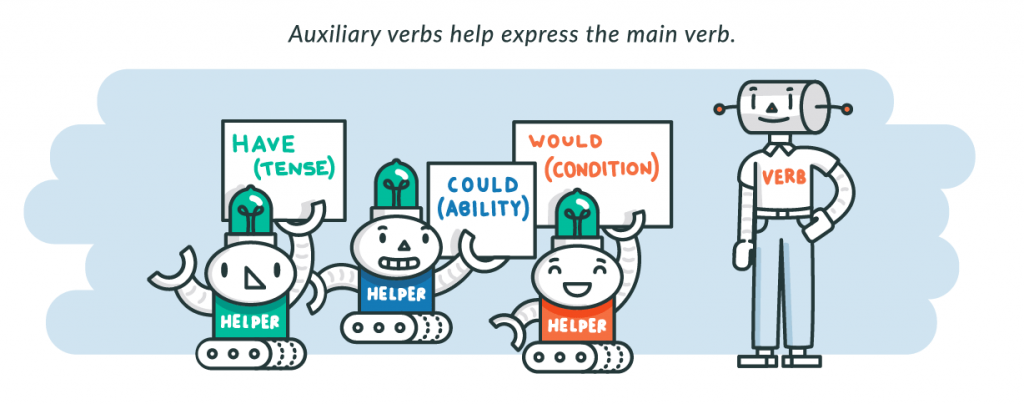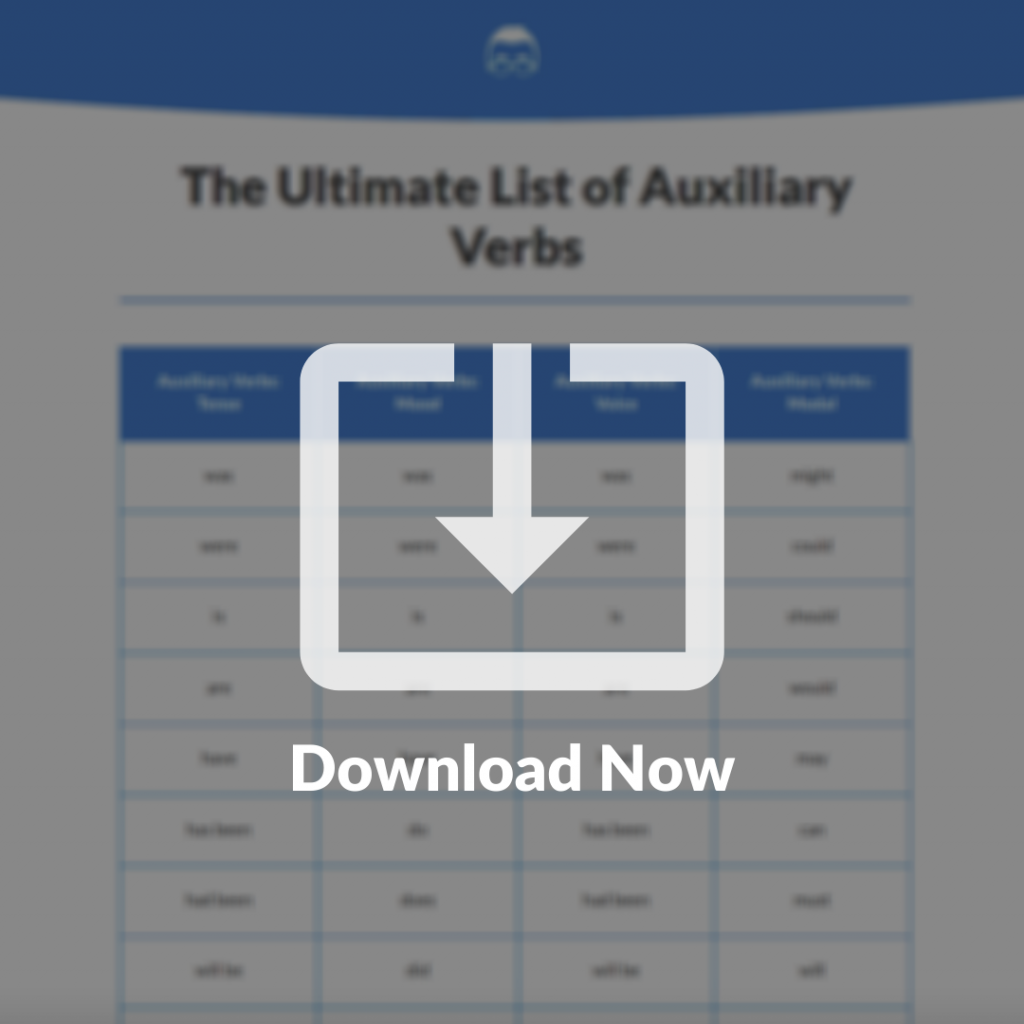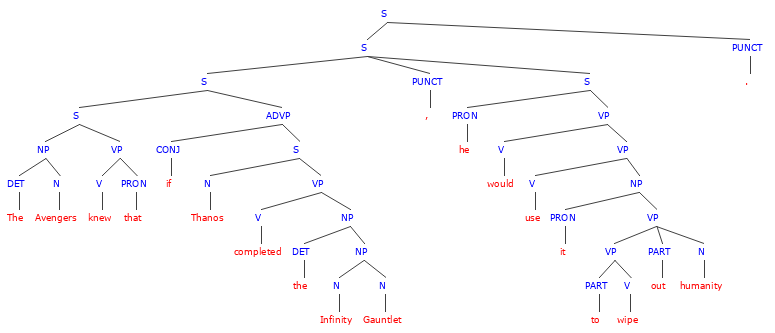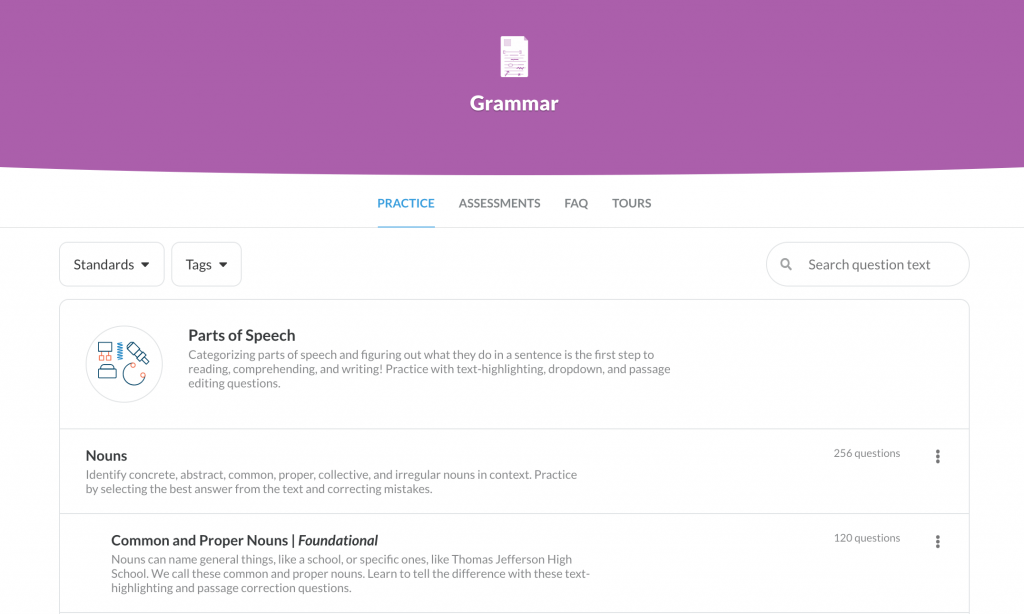| Auxiliary Verbs: Definition, Examples, & Exercises | 您所在的位置:网站首页 › auxiliary verb › Auxiliary Verbs: Definition, Examples, & Exercises |
Auxiliary Verbs: Definition, Examples, & Exercises
|
Just like nouns, verbs are an essential part of any sentence. Without either, you cannot express a complete thought. However, there are some types of verbs whose purpose is to “help” other verbs. These verbs are called auxiliary verbs. Auxiliary verbs cannot exist by themselves in a sentence; they must be connected to another verb. These “helping” verbs can connect to both action and linking verbs in order to add tense, mood, voice, and modality to these verbs. In this blog post, we will focus on learning how to recognize and use auxiliary verbs, but you can learn more about the other types of verbs on the Albert website. When you’re ready, test yourself with a quiz and practice with our high-quality, standards-aligned questions here. What We Review The Basics of Auxiliary Verbs What is an auxiliary verb?
What is an auxiliary verb?
An auxiliary verb “helps” the main verb of the sentence by adding tense, mood, voice, or modality to the main verb. Auxiliary verbs cannot stand alone in sentences; they have to be connected to a main verb to make sense. For example, a sentence that used the auxiliary verb, could, would also need a main verb for this helping verb to make sense. Look at the following incorrect sentence: “She could not whether she wanted to dye her hair blue or purple.”Something is missing, right? There is the auxiliary verb, could, and an adverb, not, but we need the main verb, decide, for the auxiliary verb to do its job in the sentence. The sentence should read: “She could not decide whether she wanted to dye her hair blue or purple.” The auxiliary verb helps the reader understand that the girl in the sentence was unable to make a decision. The main verb cannot express this indecision without the help of the auxiliary verb.  What are the four different types of auxiliary verbs?
What are the four different types of auxiliary verbs?
Since auxiliary verbs help the main verb express tense, mood, and voice, there are three different kinds of auxiliary verbs to perform these three different functions. Auxiliary Verbs that Express TenseThese auxiliary verbs can sometimes be confused with linking verbs, so it is important to use the context of the surrounding words in the sentence, or context clues, to know which verb is being used. For example: He was glad that he was wearing his seatbelt when the car accident happened.
In the sentence above, can you tell which verb is auxiliary and which is linking? The first was links the subject, he, to a state of being, happy, so this is a linking verb. The second was is followed immediately by a main verb, wearing, so this is an auxiliary verb. The phrase was wearing is an example of a main verb paired with an auxiliary verb showing tense. This particular verb tense is called past progressive because it expresses an ongoing action that happened in the past. Auxiliary Verbs that Express MoodOftentimes, auxiliary verbs that express mood are used in sentences that ask a question or sentences that make a command. Here is an example interrogative sentence, or a sentence that asks a question: Did you remember to feed the dog yesterday?Even though this auxiliary verb is separated from the main verb by the noun subject, it is still helping the main verb by asking whether something was done yesterday or not. Additionally, these auxiliary verbs can be used in commands, or imperative sentences. For example: Do not forget to walk the dog while I am at work!In this sentence, the auxiliary verb adds emphasis to the main verb showing that it is absolutely necessary to make sure that the dog is walked.  Auxiliary Verbs that Express Voice
Auxiliary Verbs that Express Voice
Sometimes voice can refer to a writer’s specific style, but in this context, voice refers to the difference between active and passive voice. When a verb is written in active voice, the action is done by the subject of the sentence. For example: The lone dolphin called anxiously for his pod when he found himself surrounded by hungry orcas.In this sentence, the subject, dolphin, is performing the action of the sentence, which is called. However, if the voice was changed from active to passive, the subject could no longer do the action and it would look like this: The pod of dolphins was called by the anxious dolphin who was now surrounded by hungry orcas.The auxiliary verb, was, allows the writer to change the voice of the sentence from active to passive while keeping the same main verb.  Auxiliary Verbs that Express Modality
Auxiliary Verbs that Express Modality
There is a fourth type of auxiliary verb that expresses possibility or ability, and these are called modal auxiliaries. Remember the sentence about the girl wanting to dye her hair? Since she could not decide which color to use, this is an example of a modal auxiliary because it expresses ability. Sure, maybe if she did more research or got input from her friends she could eventually make a decision, but as it stands in the sentence, she was unable to make up her mind, making it necessary for the writer to use one of these auxiliary verbs. What is the relationship between these different types of auxiliary verbs?Although these four types of auxiliary verbs are used by writers for different purposes, they each help the main verb in some way, and can even be used together in the same sentence. As a recap of what we learned above, remember that some auxiliary verbs express tense, or when the main verb occurred. For example: He will bake a cake later for his mom’s birthday party.Also remember that other auxiliary verbs express mood, and these can be used in asking questions or making commands. For example: Will you be at the birthday party later?Additionally, auxiliary verbs can also express passive voice. If the writer wants the subject to receive the action instead of do the action in the sentence, they would use one of these auxiliary verbs to express voice. For example: Her invitation has not been sent.Finally, auxiliary verbs can express modality, which can include everything from ability, permission, likelihood, or advice. For example: You should not go for a five-mile run after eating an entire birthday cake.
Here are some examples of some of these different types of auxiliary verbs being used together: Was the vase broken while you were dancing around the living room? (mood and tense) Could you have been out of breath earlier because you were being chased by several angry squirrels? (mood, modality, and voice) Check out our grammar review libraryReturn to the Table of Contents 3 Tips for Understanding Auxiliary VerbsHere are some important tips to help you understand auxiliary verbs:  Tip #1. Auxiliary verbs cannot be the main verb of the sentence
For example, the phrase, “she would if she could” does not make much sense without a main verb.The reader is left asking, “she would what if she could what?” Therefore, the sentence has to include a main verb and read like this: “she would have her cavity filled if she could only overcome her fear of dentists.”
Tip #1. Auxiliary verbs cannot be the main verb of the sentence
For example, the phrase, “she would if she could” does not make much sense without a main verb.The reader is left asking, “she would what if she could what?” Therefore, the sentence has to include a main verb and read like this: “she would have her cavity filled if she could only overcome her fear of dentists.”
 Tip #2. The job of auxiliary verbs is to help the main verb
A main verb can function on its own without the help of an auxiliary verb, but sometimes an auxiliary verb is needed to help expand the meaning of the main verb by adding tense, mood, voice, or modality A sentence is complete without an auxiliary verb; however, it may not express the full meaning of the sentence that the writer intends. For example: She finished her art project because she was missing some crucial supplies. Does this sentence make sense? Although it is grammatically correct, it does not make sense because it is missing an important auxiliary verb to help the verb sound consistent with the rest of the sentence. Sentence with added auxiliary verb: She was not able to finish her art project because she was missing some crucial supplies.
Tip #2. The job of auxiliary verbs is to help the main verb
A main verb can function on its own without the help of an auxiliary verb, but sometimes an auxiliary verb is needed to help expand the meaning of the main verb by adding tense, mood, voice, or modality A sentence is complete without an auxiliary verb; however, it may not express the full meaning of the sentence that the writer intends. For example: She finished her art project because she was missing some crucial supplies. Does this sentence make sense? Although it is grammatically correct, it does not make sense because it is missing an important auxiliary verb to help the verb sound consistent with the rest of the sentence. Sentence with added auxiliary verb: She was not able to finish her art project because she was missing some crucial supplies.
 Tip #3. Auxiliary verbs help the main verb by adding tense, mood, voice, or modality
Auxiliary verbs can perform many different functions in order to help the main verb, and it is important to remember these many possibilities as writers For example, the auxiliary verb have, has, and had can be used in several different ways: To express tense: We have been to that amusement park before. To express mood: Have you been to that amusement park before? To express voice: The park has been visited by us before. To express modality: You should have visited the park when you were in the area.
Tip #3. Auxiliary verbs help the main verb by adding tense, mood, voice, or modality
Auxiliary verbs can perform many different functions in order to help the main verb, and it is important to remember these many possibilities as writers For example, the auxiliary verb have, has, and had can be used in several different ways: To express tense: We have been to that amusement park before. To express mood: Have you been to that amusement park before? To express voice: The park has been visited by us before. To express modality: You should have visited the park when you were in the area.
 Start Practicing on Albert Now
Start Practicing on Albert Now
Return to the Table of Contents Applying the Basics: Auxiliary Verb Review & PracticeNow that you understand how auxiliary verbs are used in sentences, review the anchor chart below and complete the review to fully understand auxiliary verbs. The Ultimate List of Auxiliary VerbsRefer to the graphic below to learn the different types of auxiliary verbs:  Download this free resource
Download this free resource
This list, obviously, does not include all possible auxiliary verbs; however, it is meant to be used as a guide while identifying this type of verb. Return to the Table of Contents Auxiliary Verb Exercises and ReviewNow that you know some common auxiliary verbs, test your ability to accurately identify these verbs in the sentences below. 
Select the auxiliary verb(s) in the sentences below. Remember, these verbs cannot stand alone in sentences and must help the main verb. 1. The Avengers knew that if Thanos completed the Infinity Gauntlet, he would use it to wipe out humanity. In this sentence, would is an auxiliary verb showing modality, or the possibility of Thanos wiping out humanity.2. Loki was planning to steal the Tesseract before Thor stopped him. In this sentence, was is an auxiliary verb that shows tense, or when Loki attempted his theft of this precious artifact.3. The soldiers were freed by Captain America in a daring rescue mission. In this sentence, were is an auxiliary verb showing passive voice since the subject, the soldiers, are receiving the action instead of doing it.4. “Are you skipping school to participate in dangerous missions?” Tony Stark asked Peter Parker. In this sentence, are is an auxiliary verb showing mood. Tony is asking Peter whether or not he really is skipping his classes by using this auxiliary verb.5. “What would you do if you were in my shoes?” Black Widow asked Hawkeye. In this sentence, would and were are both auxiliary verbs. Would is an auxiliary verb showing mood and modality; it is used to ask a question, but this is a hypothetical question. Were is an auxiliary verb showing tense and mood.
Pro tip: When evaluating whether a verb is an auxiliary verb, ask yourself these questions: Is the verb standing on its own in the sentence as the main verb? If so, it is either an action verb or a linking verb. Is the verb helping another verb in the sentence by adding tense, mood, or voice.For additional practice, check out Auxiliary Verb content on Albert. Check out our grammar review libraryReturn to the Table of Contents Try for Yourself: Auxiliary Verbs Quiz
Feeling confident in your understanding of auxiliary verbs? Take this short six-question quiz to see what you’ve learned: Start the quiz1. Can an auxiliary verb stand alone in a sentence? Answer: No Correct Explanation: That’s right! An auxiliary verb cannot stand on its own in a sentence and must be paired with a main verb. Incorrect Explanation: Sorry, that’s not right! Remember, an auxiliary verb cannot stand on its own in a sentence and must be paired with a main verb.2. Can the same auxiliary verb help the main verb in different ways depending on how it is used in a sentence? Answer: Yes Correct Explanation: That’s right! The same auxiliary verbs can help the main verb by adding either tense, mood, voice, or modality. Incorrect Explanation: Sorry, that’s not right! Remember, the same auxiliary verbs can help the main verb by adding either tense, mood, voice, or modality.3. In this sentence, does the auxiliary verb help the main verb express voice or tense? He was trying to explain where he was coming from before he was rudely interrupted. Answer: TenseCorrect Explanation: That’s right! The verb was is used three times to show tense, or when he was trying to speak and was interrupted. Incorrect Explanation: Sorry, that’s not right! Remember, an auxiliary verb that shows tense expresses when the action happened. An auxiliary verb that shows voice expresses how the action was received by the subject.4. In this sentence, does the auxiliary verb help the main verb express voice or tense? On Black Friday, the local mall was rushed by greedy shoppers determined to snag some great deals. Answer: VoiceCorrect Explanation: That’s right! The verb was shows that the action, rushed, was received by the local mall, establishing passive voice. Incorrect Explanation: Sorry, that’s not right! Remember, an auxiliary verb that shows tense expresses when the action happened. An auxiliary verb that shows voice expresses how the action was received by the subject.5. In this sentence, does the auxiliary verb help the main verb express mood or modality? Are you working next Friday? Answer: MoodCorrect Explanation: That’s right! The auxiliary verb are expresses mood by asking whether or not someone is working. Incorrect Explanation: Sorry, that’s not right! Remember, auxiliary verbs that express mood are often in the form or questions or commands. Auxiliary verbs that express modality focus on possibility, ability, permission, or advice.6. In this sentence, does the auxiliary verb help the main verb express mood or modality? You should not work next Friday since you are not feeling well. Answer: Modality Correct Explanation: That’s right! The auxiliary verb should expresses permission or advice to not work due to sickness. Incorrect Explanation: Sorry, that’s not right! Remember, auxiliary verbs that express mood are often in the form or questions or commands. Auxiliary verbs that express modality focus on possibility, ability, permission, or advice.For additional practice with auxiliary verbs, check out our practice on Albert: Auxiliary Verbs. Return to the Table of Contents Teacher’s Corner for Auxiliary VerbsWhile understanding auxiliary verbs may not seem to be as important as understanding action and linking verbs, the Common Core English Language Progressive Skills Chart shows that comprehension of all types of verbs is essential for all ages and levels of both readers and writers. For specific standards addressing these different types of auxiliary verbs, check out the Common Core State Standards site. Albert’s Auxiliary Verb Practice is a great tool for practicing these types of verbs, whether as an in-class or homework assignment. Our assessments are a great tool for both pre-and post-tests to gauge student comprehension, and teachers have the ability to use either a pre-made assessment or to create their own. Check out our grammar review libraryReturn to the Table of Contents Summary for Auxiliary VerbsAuxiliary Verbs help the main verb by adding tense, mood, voice, and modality. Many auxiliary verbs can be used to help the main verb in more than one way, so pay attention to the context of the entire sentence to understand best how the auxiliary verb is being used. Be sure to check out our grammar course for more auxiliary verb practice. You can also access over 3,400 high-quality questions that address nearly every grammatical concept. Need help preparing for your Grammar exam?
Albert has hundreds of grammar practice questions with detailed explanations to help you master concepts. Start Practicing on Albert Now |
【本文地址】